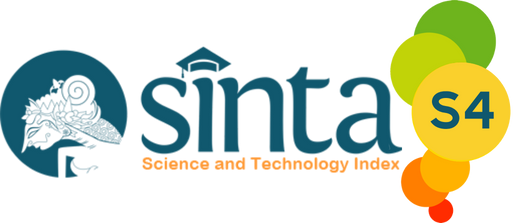Analysis of Student Learning Interests Based on Peer Learning Interests According to Crowds Behavior Theory
Abstract
Keywords
Full Text:
PDFReferences
Achmad, F. R., & Pramudiani, P. (2022). Minat Belajar Siswa Pada Pembelajaran Teknologi Informasi dan Komunikasi (TIK) Kelas IV Selama Pembelajaran Daring di Madrasah Ibtidaiyah. Jurnal Cakrawala Pendas, 8(4), 950-960. doi: https://dx.doi.org/10.31949/jcp.v8i2.2719
Allport, G. W. (1924). The study of the undivided personality. The Journal of Abnormal Psychology and Social Psychology, 19(2), 132. doi: https://doi.org/10.1037/h0064744
Ampofo, I. A. S., & Ampofo, I. A. J. The Influence Of Project Work Approach On College Students Interest In Programming At The Private Universities In Ghana. IJIE (Indonesian Journal of Informatics Education), 6(1). doi: https://dx.doi.org/10.20961/ijie.v6i1.59461
Damon, W. (1984). Peer Education: The Untapped Potential. Journal of Applied Developmental Psychology, 5(4), 331-343. doi: https://doi.org/10.1016/0193-3973(84)90006-6
Deddy, M. (2018). Metodologi Penelitian Kualitatif: Paradigma Baru Ilmu Komunikasi dan Ilmu Sosial Lainnya, Bandung: PT. Remaja Rosdakarya.
Farizi, M. Y., Maryono, D., & Liantoni, F. (2020). Efektivitas Penerapan Project Based Learning Melalui Pembuatan Konten Video Terhadap Minat dan Hasil Belajar Peserta Didik pada Mata Pelajaran Desain Grafis Percetakan di SMK Negeri 6 Surakarta. Journal of Informatics and Vocational Education, 3(3), 82-86. doi: https://dx.doi.org/10.20961/joive.v3i3.47568
Festinger, L. (1954). A theory of social comparison processes. Human relations, 7(2), 117-140. doi: https://doi.org/10.1177/001872675400700202
Hasri, S., Basori, B., & Maryono, D. (2019). Game-Based Learning Effectiveness With The Kahoot Application Viewed From Learning Interests And Learning Outcomes Of Learners In Digital Simulation Subjects. Indonesian Journal of Informatics Education, 3(1), 31-38. doi: https://doi.org/10.20961/ijie.v3i1.32116
Interview with one of the PPLG teachers at a State Vocational School in Surakarta, on October 31, 2023.
Juniantoro, F. D. (2018). Hubungan Teman Sebaya dan Minat Belajar Terhadap Hasil Belajar Muatan Bahasa Indonesia Siswa Kelas IV Gugus Wijaya Kusuma Kecamatan Pedurungan Kota Semarang. Joyful Learning Journal, 7(1), 10-16. doi: https://doi.org/10.15294/jlj.v7i1.25484
Le Bon, G. (2002). The crowd: A study of the popular mind. Courier Corporation.
Lew-Levy, S., van den Bos, W., Corriveau, K., Dutra, N., Flynn, E., O’Sullivan, E., Pope-Caldwell, S., Rawlings, B., Smolla, M., Xu, J., & Wood, L. (2023). Peer Learning and Cultural Evolution. Child Development Perspectives, 17, 97–105. doi: https://doi.org/10.1111/cdep.12482
Lewis, M. (2005). The Child and Its Family: The Social Network Model. Human Development, 48(1– 2), 8– 27. doi: https://doi.org/10.1159/000083213.
Mustikaningrum, D., Maryono, D., & Yuana, R. A. (2020). Eksperimentasi Discovery Learning dan Project Based Learning Kombinasi College Ball Ditinjau dari Minat Pada Materi Kontrol Percabangan Kelas X SMK Negeri 6 Surakarta Tahun Ajaran 2015/2016. Jurnal Ilmiah Pendidikan Teknik Dan Kejuruan, 13(1), 30-36. doi: https://doi.org/10.20961/jiptek.v13i1.24278
Nasution, N. C. (2018). Dukungan Teman Sebaya Dalam Meningkatkan Motivasi Belajar. Al-Hikmah: Jurnal Dakwah, 12(2), 159-174. doi: https://doi.org/10.24260/al-hikmah.v12i2.1135
Oktaviani, D. O. D., & Perianto, E. (2022). Pengaruh dukungan teman sebaya terhadap minat belajar siswa. Teraputik: Jurnal Bimbingan Dan Konseling, 6(1), 127-134. doi: https://doi.org/10.26539/teraputik.611093
Putri, D. A. E., & Ariani, D. (2022). Pengaruh Teman Sebaya Terhadap Minat Belajar Peserta Didik Kelas VIII di SMP Negeri 5 Kota Solok: The Effect Of People Friends On Students'learning Interest Class VIII At SMP Negeri 5 Kota Solok. Bakoba: Journal of Social Science Education, 2(1), 122-126. doi: https://doi.org/10.30606/bakoba.v2i1
Santrock, J. W. (2011). Perkembangan anak edisi 7 jilid 2. Terjemahan: Sarah Genis B) Jakarta: Erlangga, 251.
Slameto. (1988). Belajar dan Faktor-faktor yang Mempengaruhinya. Bina Aksara.
Sugiyono, D. (2013). Metode penelitian pendidikan pendekatan kuantitatif, kualitatif dan R&D.
Turner, D. P. (2020). Sampling methods in research design. Headache: The Journal of Head and Face Pain, 60(1), 8-12. doi: https://doi.org/10.1111/head.13707
Refbacks
- There are currently no refbacks.








